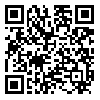Volume 6, Issue 1 (Occupational Medicine Quarterly Journal 2014)
tkj 2014, 6(1): 9-16 |
Back to browse issues page
Mohammad Moghiseh * 
 , Ehsan Habibi
, Ehsan Habibi 
 , Akbar Hasanzadeh
, Akbar Hasanzadeh 
 , Mohammad Kazem Khorvash
, Mohammad Kazem Khorvash 
 , Nahal Aramesh
, Nahal Aramesh 
 , Amir Hossein Poorrahmatian
, Amir Hossein Poorrahmatian 


 , Ehsan Habibi
, Ehsan Habibi 
 , Akbar Hasanzadeh
, Akbar Hasanzadeh 
 , Mohammad Kazem Khorvash
, Mohammad Kazem Khorvash 
 , Nahal Aramesh
, Nahal Aramesh 
 , Amir Hossein Poorrahmatian
, Amir Hossein Poorrahmatian 

Abstract: (7982 Views)
Background: The importance of ergonomics is to create fit between work and human physiology using assessment methods of physical, physiological and subjective evaluation. The most commonly used tool for assessment of subjective symptoms is Borg scale during physical work and heart rate in physiological situations. This study is based on a subjective and physiological assessment during hard work in one of the metal industry in Isfahan.
Method: In this study, 200 male workers have entered voluntarily according to the Strand study protocol and were evaluated by ergometer. Subjects were asked to report Borg scale at the end of each minute pricing during the experiment, and the heart rate at the end of each minute was recorded by the device.
Result: There was a very strong correlation between the perceived intensity of effort as a subjective factor and ergometer increased workload (R^2= 0/91),(P<0.0001). Heart rate as a physiological factor associated with an increased workload and stiffness (R^2=0/96),(P<0.0001). Linear regression analysis of the relationship between perceived effort and workload was as equation Workload= 126.54 - 4.45 (RPE) and linear regression analysis of the relationship between heart rate and physical workload was as equation Workload= 125.89 – 0.54 (HR). In other words, the physical workload and heart rate has a more significant relationship than rating of perceived exertion with physical workload.
Consequences: With a developed regression equation without any laboratory facilities, the workload of physical work is easily measurable. The physical working ability could be estimated based on measuring heart rate during work, or on the basis of changes in perceived physical ability and mental labor monitoring, so the required periodic checkups, education, etc. could be done.
Type of Study: Research |
Subject:
Ergonomics
Received: 2014/04/20 | Accepted: 2014/04/20 | Published: 2014/04/20
Received: 2014/04/20 | Accepted: 2014/04/20 | Published: 2014/04/20
| Rights and permissions | |
 |
This work is licensed under a Creative Commons Attribution-NonCommercial 4.0 International License. |
